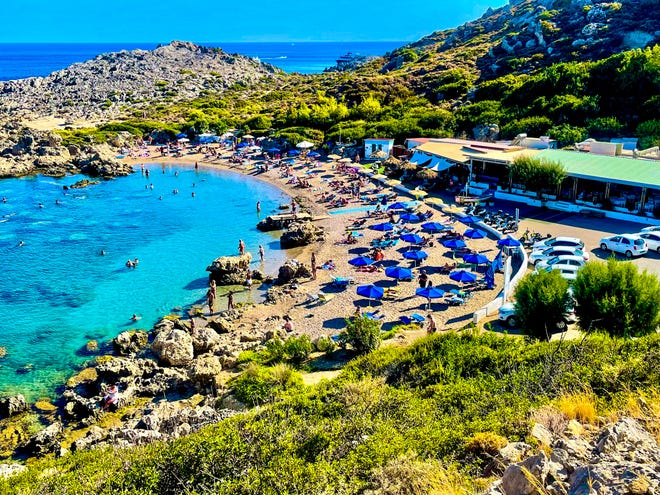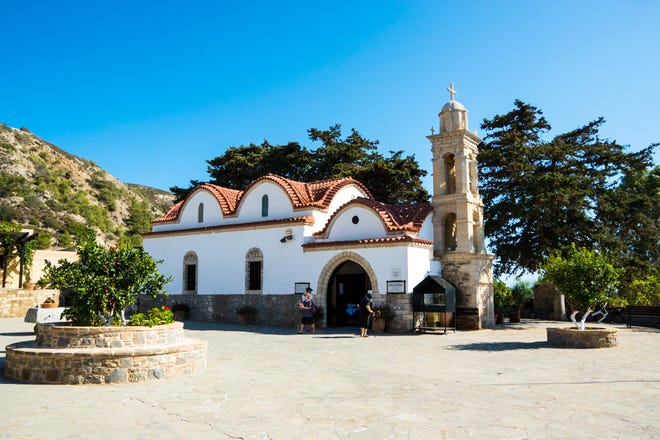When travelers plan a visit to Greece’s Aegean Seas, it’s fashionable to consider Mykonos and Santorini, two of the world’s most frequented (and most heavily touristed) islands.
But there’s an alternative: Sun-splashed Rhodes. Greece’s fourth largest island and largest of the Dodecanese chain provides sojourners with nearly 100 beautiful, laid-back beaches; important historical sites, including the Lindos Acropolis; adventure activities such as kite surfing, and a rousing nightlife.
Once conquered by Ottoman Turks, later under Italian rule, Rhodes features a unique cuisine highlighting products and kitchen styles introduced by its sovereigns. What’s more, the island is lined with ceramics shops, in keeping with Greece’s reputation for fine antiquities, pottery and other artifacts.
In summer, like most of Greece, Rhodes is jam-packed with visitors. But take solace in knowing the island is big enough to escape crowds.
Gallery:A 14-day journey exploring Costa Rica, Panama rainforests
Norway’s Svalbard archipelago, Greenland:Exploring two of the northernmost places the world
Here’s a sampling of what to expect in Rhodes, Greece.

One of Greece’s most exciting walks is a stroll through the walls of Old Town Rhodes, the oldest inhabited medieval enclave in Europe and a UNESCO World Heritage Site. Nearly 200 streets and alleys reveal a hidden past, their Byzantine and Gothic architecture framed by a unique backdrop.

The Acropolis of Lindos, one of Greece’s best-preserved ruins, is the most impressive archeological site on Rhodes. The ancient citadel rises 400 feet above the ivory town of Lindos. It requires a climb of more than 300 steps.

One of the island’s finest beaches is St. Paul’s Bay, adjacent to Lindos. It is named after the Christian apostle who landed on its shores in 51 A.D. to spread the gospel of Jesus.

The Palace of the Grand Masters of the Knights of Rhodes, one of the few Gothic structures in Greece, was built in the 14th century at the height of the Byzantine Empire. Seen from anywhere in Rhodes Town, it is a medieval marvel with a fairy-tale appeal.

Anthony Quinn Bay was named for the popular Mexican actor who filmed “The Guns of Navarone” on Rhodes in 1961. One of several strands here is Ladiko Beach, in a quiet cove where a beach bar offers freshly squeezed orange juice.

Family-run ceramics shops sell the work of a new generation of skilled artisans throughout the island. Clay pottery has been produced in Greece since the early Neolithic period, about 6000 B.C.

The typical Rhodian diet consists of fresh Aegean seafood and various small plates, including a meze selection of vegetables and legumes. Invasions by Romans, Turks, Persians, Saracens, and Venetians influenced the island’s cuisine. Conversely, Aristotle once said the Greek Mediterranean diet was marked by excessive and unhealthy eating and drinking.

The seaside spa of Kallithea Springs is on the east side of Rhodes island. Reopened in 2007 after a 10-year restoration, it features a Moorish rotunda at the heart of flourishing gardens and an underground 14th-century chapel. Peacocks roam freely on the grounds.

The four massive columns of the Doric temple of Athena Lindia are in the extreme northern section of the Lindos citadel. They are the most distinguishable landmarks on the island. Rhodes was also renowned for its 3rd Century statue of the sun god, Helios, better known as the Colossus of Rhodes. One of the Seven Wonders of the Ancient World, it stood for only 54 years before collapsing in an earthquake.

Located on Stavros Hill near the village of Messanagros, the Monastery of Skiadi is one of eight important sacred sites on Rhodes. Built between the 9th and 11th centuries, it once provided a haven for those persecuted during Ottoman rule. It has been renovated several times.

Exhilarating excursions on all-terrain vehicles encourage visitors to get off the beach, combining nature trips with panoramic views. Rhodes Adventures offers ATV trips and Jeep safaris, traversing the island’s central mountains to rock climb and rappel. Stops on a three-hour journey include a local honey and wine shop.

On picture-perfect St. Paul’s Beach, the Tambakio Restaurant and Bar tempt al fresco diners with beachfront cabanas and the freshest catch of the day, including Linden prawns with Ouzo, fried calamari, risotto and pasta.

The island’s only city is vibrant Rhodes Town, the capital of the Dodecanese archipelago and home to about 50,000 people. The medieval Street of the Knights is jam-packed with restaurants, bars and shops.

An authentic Rhodes experience must include a visit the estate and restaurant of Anastasia Triantafillou in the inland settlement of Petaloudes. The winery offers tastings and cooking classes, where you can also learn the local wine-making process, from the cultivation of grapes to the eventual distilling.

Medieval culture fills the meandering streets of Old Town Rhodes, which are especially popular with shoppers. Ancient alleyways are lined with shops selling ceramics, fashions and other keepsakes.

The Lindos Acropolis looms large from various vantage points on the island. Silhouetted against a blue backdrop, nearly 400 feet above the village of Lindos, the acropolis offers astonishing views of St. Paul’s Bay and the vast Aegean Sea.

Bathing in Kallithea Bay is worth the small price of admission. The long inlet with translucent water, flanked by restaurant terraces and sun loungers, opened in July of 2007 and is well worth a visit for dining and swimming.
Kritinia Castle, built in the 15th Century by Venetians, is located in the remote west of the island. It is part of a compound that includes the 16th-century St. John’s chapel, decorated with frescoes of timepieces. A coat of arms from 41st Grand Master Emery D’Amboise is identified on the historic site.

A unique experience on Rhodes is a visit to Seven Springs, an inland oasis and protected zone. Water flows from its springs year-round. Follow a footpath or walk through a dark tunnel to get to a small lake in the park. The area is perfect for trekking the forested terrain.

Adjacent to Rhodes town is the yachting port of Mandraki. From its marina, ferries and cruise ships connect to other Greek Islands. Popular from Rhodes is a day trip to idyllic Symi, a one-hour ride. A highlight is the St. Nicholas Fortress, built in 1480 to honor the patron saint of seamen.

Island restaurants features all types of cuisine and styles, from fine dining to casual meze appetizer plates. Rhodian meals often consist of small plates meant to be shared; they pair well with local wine.

A boat tour is a great way to discover the island of Rhodes. Private yachts take visitors to the island’s best beaches and swim spots. Catamaran sightseeing cruises include lunch and drinks; other options afloat include kayaking and snorkeling.

The Greek islands are well known for their spectacular sunsets. It is said that the god Apollo would travel great lengths in his chariot simply to watch each day end here. Indeed, it is difficult not to be captivated by the sheer beauty of the sunset.


